NCERT Exemplar Class 11 Chemistry Chapter 4 Chemical Bonding and Molecular Structure are part of NCERT Exemplar Class 11 Chemistry . Here we have given NCERT Exemplar Class 11 Chemistry Chapter 4 Chemical Bonding and Molecular Structure.
NCERT Exemplar Class 11 Chemistry Chapter 4 Chemical Bonding and Molecular Structure
Multiple Choice Questions
Single Correct Answer Type
Q1. Isostructural species are those which have the same shape and hybridization. Among the given species identify the isostructural pairs.
(a) [NF
3
and BF
3
]
(b) [BF
–
4
andNH
+
4
]
(c) [BC1
3
and BrCl
3
]
(d) [NH
3
and N0
–
3
]
Sol:
(b) NF
3
is pyramidal whereas BF
3
is planar triangular.
BF
–
4
and NH
+
4
ions both are tetrahedral.
BC1
3
is triangular planar whereas BrCl
3
is pyramidal.
NH
3
is pyramidal whereas N0
3
is triangular planar.
Q2. Polarity in a molecule and hence the dipole moment depends primarily on electronegativity of the constituent atoms and shape of a molecule. Which of the following has the highest dipole moment?
(a) C0
2
(b) HI
(c) H
2
0
(d) S0
2
Sol:
(c) H
2
0 will have highest dipole moment due to maximum difference in electronegativity of H and O atoms.

Q3. The types of hybrid orbitals of nitrogen in N0
2
, N0
3
and NH
4
respectively are expected to be
(a) sp, sp
3
and sp
2
(b) sp, sp
2
and sp
3
(c) sp
2
,
sp
and sp
3
(d) sp
2
, sp
3
and sp
Sol:
(b) The number of orbitals involved in hybridization can be determined by the application of formula:

where H = number of orbitals involved in hybridization
V= valence electrons of central atom
M= number of monovalent atoms linked with central atom
C = charge on the cation
A = charge on the anion
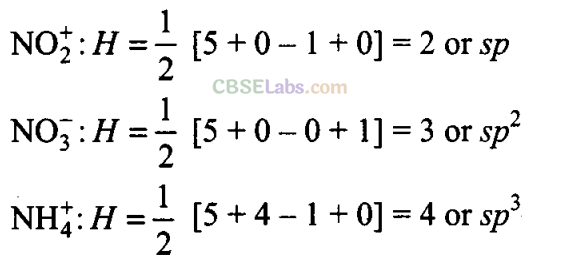
Q4. Hydrogen bonds are formed in many compounds e.g., H
2
0, HF, NH
3
. The boiling point of such compounds depends to a large extent on the strength of hydrogen bond and the number of hydrogen bonds: The correct decreasing order of the boiling points of above compounds is
(a) HF>H
2
0>NH
3
(b) H
2
0>HF>NH
3
(c) NH
3
>HF>H
2
0
(d) NH
3
>H
2
0>HF
Sol: (b) Strength of H-bonding depends on the electronegativity of the atom which follows the order: F > O > N .
Strength of H-bond is in the order:
H……. F > H…….. O > H…….. N
But each H
2
0 molecule is linked to 4 other H
2
0 molecules through H-bonds whereas each HF molecule is linked only to two other HF molecules.
Hence, correct decreasing order of the boiling points is H
z
O > HF > NH
3
.
Q5. In PO
4
3-
ion the formal charge on the oxygen atom of P – O bond is
(a) +1 (b) -1 (c) -0.75 (d) +0.75
Sol:
(b) Formal charge of the atom in the molecule or ion = (Number of valence electrons in free atom) – (Number of lone pair electrons + 1/2 Number of bonding electrons)

Q6. In N0
–
3
ion, the number of bond pairs and lone pairs of electrons on nitrogen atom are
(a) 2, 2 (b) 3, 1 (c) 1,3 (d) 4, 0
Sol:
(d) In N-atom, number of valence electrons = 5
Due to the presence of one negative charge, number of valence electrons = 5 + 1 = 6. One O-atom forms two bonds (= bond) and two O-atom are shared with two electrons of N-atom.
Thus, 3 O-atoms are shared with 8 electrons of N-atom.
Number of bond pairs (or shared pairs) = 4
Number of lone pairs = 0
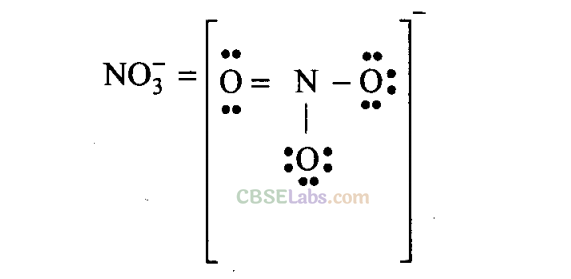
Q7. Which of the following species has tetrahedral geometry?
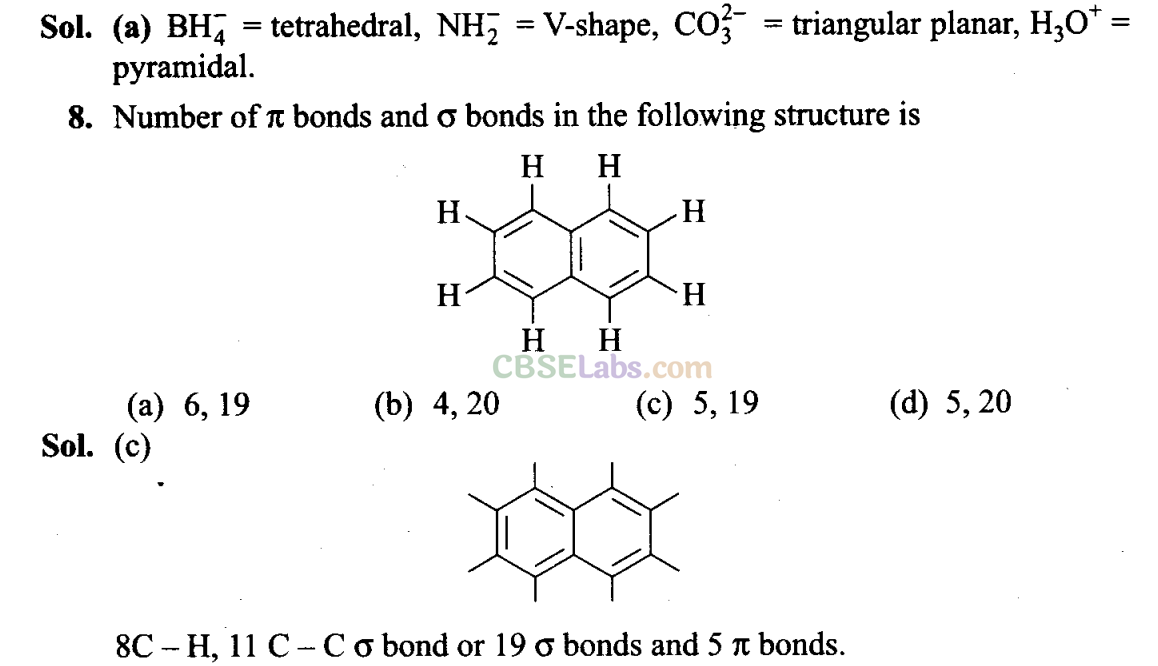
Q9. Which molecule/ion out of the following does not contain unpaired electrons?
(a) N
+
2
(b) 0
2
(c) O
2
2-
(d) B
2
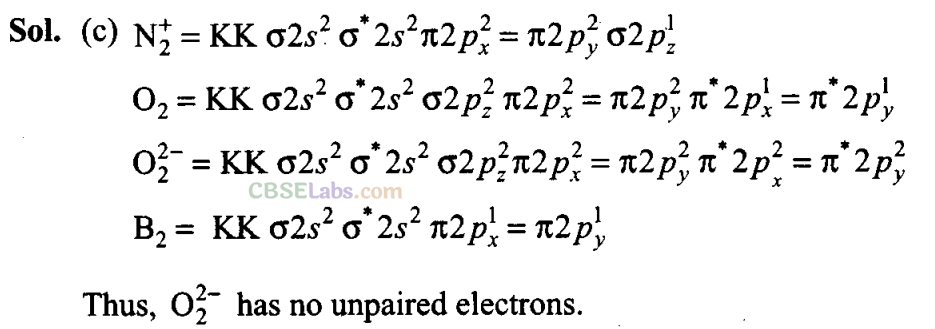
Q10. In which of the following molecule/ion all the bonds are not equal?
(a) XeF
4
(b) BF
–
4
(c) C
2
H
4
(d) SiF
4
Sol:
(c) C
2
H
4
has one double bond and four single bonds. Bond length of double bond (C = C) is smaller than single bond (C – H).
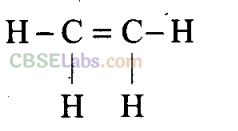
Q11. In which of the following substances will hydrogen bond be strongest?
(a) HCl
(b) H
2
0
(c) HI
(d) H
2
S
Sol:
(b) HC1, HI and H
2
S do not from H-bonds. Only H
2
0 forms hydrogen bonds. One H
2
0 molecule forms four H-bonding.
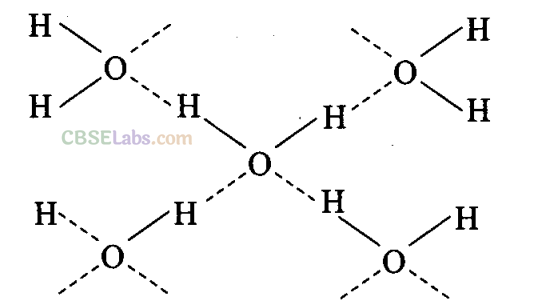
Q12. If the electronic configuration of an element is 1s
2
2s
2
2p
6
3s
2
3p
6
3d
2
4s
2
, the four electrons involved in chemical bond formation will be .
(a) 3p
6
(b 3p
6
, 4s
2
(c) 3p
6
, 3d
2
(d) 3d
1
,4s
2
Sol: (d) In transition elements (n -1 )d and ns orbitals take part in bond formation.
Q13. Which of the following angle corresponds to sp
2
hybridisation
?
(a) 90° (b) 120° (c) 180° (d) 109°
Sol:
(b) sp
2
hybridisation gives three sp
2
hybrid orbitals which are planar triangular forming an angle of 120° with each other.
The electronic configurations of three elements A, B and C are given below.
Answer the questions from 14 to 17 on the basis of these configurations.
A ls
2
2s
2
2p
6
B ls
2
2s
2
2p
6
3s
2
3p
3
C ls
2
2s
2
2p
6
3s
2
3p
s
Q14. Stable form of A may be represented by the formula
(a) A
(b) A
2
(c) A
3
(d) A
4
Sol:
(a) The given electronic configuration shows that A represents noble gas because the octet is complete. A is neon which has 10 atomic number.
Q15. Stable form of C may be represented by the formula
(a) C
(b) C
2
(c) C
3
(d) C
4
Sol:
(b) The electronic configuration of C represent chlorine. Its stable form is dichlorine (Cl
2
), i.e., C
2
.
Q16. The molecular formula of the compound formed from B and C will be
(a) BC
(b) B
2
C
(c) BC
2
(d) BC
3
Sol:
(d) B represent P and C represents Cl. The stable compound is PC1
3
i.e., BC
3
.
Q17. The bond between B and C will be
(a) ionic
(b) covalent
(c) hydrogen
(d) coordinate
Sol:
(b) Both B and C are non-metals and therefore, bond formed between them will be covalent.
Q18. Which of the following order of energies of molecular orbitals of N
2
is correct?
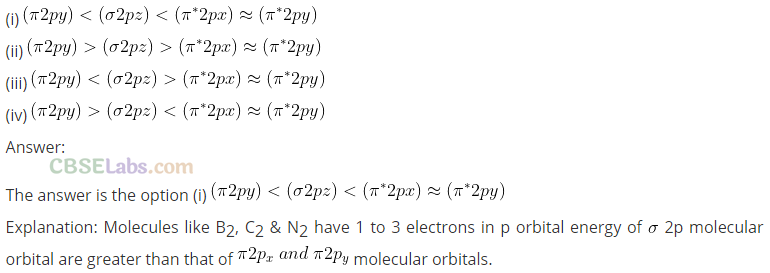
Q19. Which of the following statements is not correct from the view point of molecular orbital theory?
(a) Be
2
is not a stable molecule.
(b) He
2
is not stable but He
+
2
is expected to exist.
(c) Bond strength of N
2
is maximum amongst the homonuclear diatomic molecules belonging to the second period.
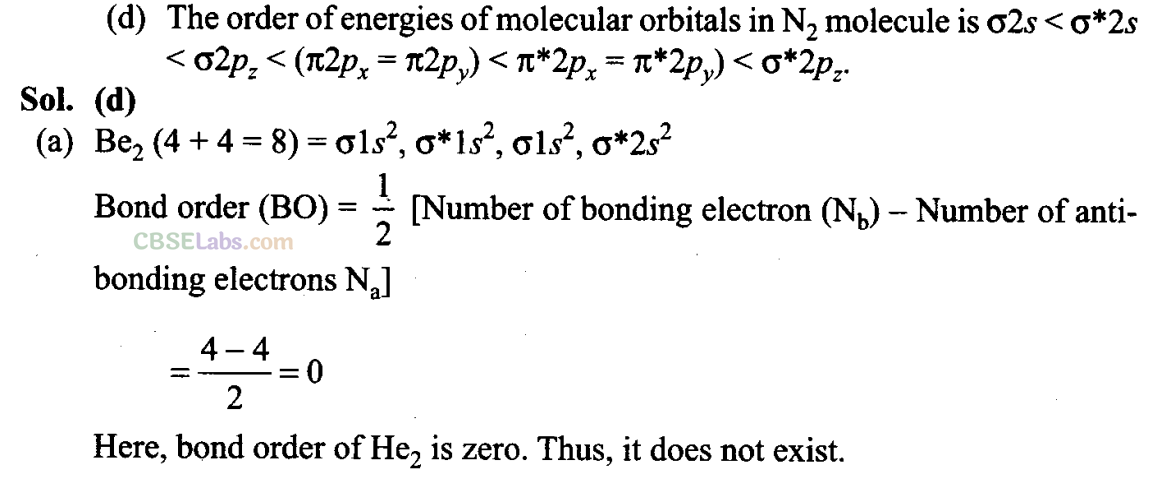
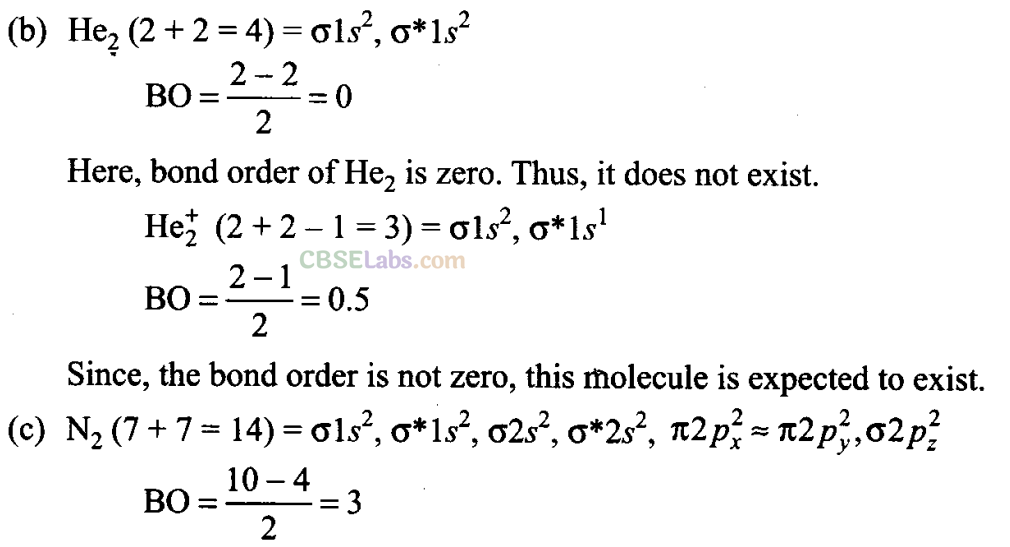
Thus, dinitrogen (N
2
) molecule contains triple bond and no other molecule of second period have more than double bond. Hence, bond strength of N
2
is maximum amongst the homonuclear diatomic molecules belonging to the second period.
(d) It is incorrect. The correct order of energies of molecular orbitals in N
2
molecule is

Q20. Which of the following options represents the correct bond order?
(a) o
2
>o
2
>o
+
2
(b) o
–
2
<o
2
<o
2
(c) o
2
>o
2
<o
2
(d) o
–
2
<o
2
>o
+
2
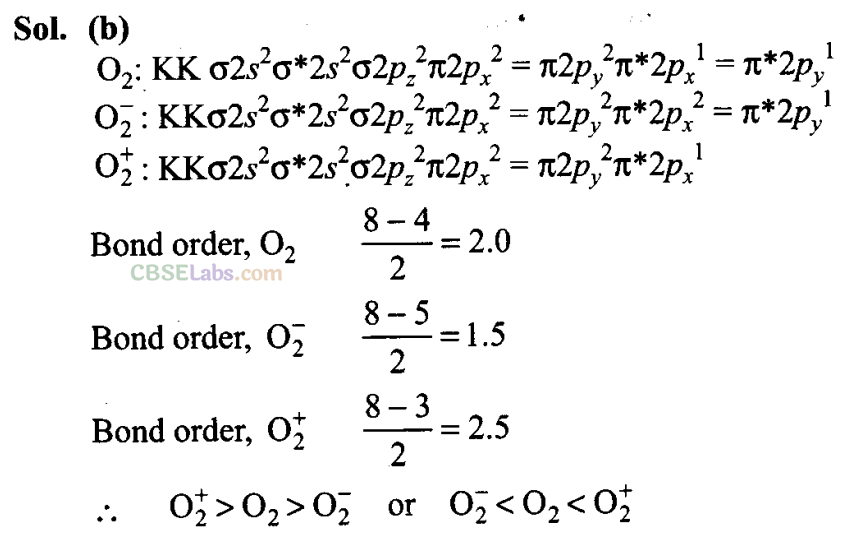
Q21. The electronic configuration of the outermost shell of the most electronegative element is
(a) 2s
2
2p
5
(b) 3s
2
3p
5
(c) 4s
2
4p
5
(d) 5s
2
5p
s
Sol:
(a) The electronic configuration represents
2s
2
2p
5
= fluorine = most electronegative element
3s
2
3p
5
= chlorine
4s
2
4p
5
= bromine
5s
2
5p
5
= iodine
Q22. Amongst the following elements, whose electronic configurations are given below, the one having the highest ionization enthalpy is
(a) [Ne]3s
2
3p
1
(b) [Ne]3s
2
3p
3
(c) [Ne]3s
2
3p
2
(d) [Ar]3d
10
4s
2
4p
3
Sol:
(b) (b) and (d) have exactly half-filled p-orbitals but (b) is smaller in size than Hence, (b) has highest ionization enthalpy.
More than One Correct Answer Type
Q23. Which of the following have identical bond order?
(a) CN
–
(b) NO
+
(c) 0
–
2
(d) 0
2
2-
Sol:
(a, b) CN
–
(number of electrons = 6 + 7 + 1 = 14)
NO
+
(number of electrons = 7 + 8 – 1 = 14)
0
–
2
(number of electrons = 8 + 8 + 1 = 17)
0
2
2-
(number of electrons = 8 + 8 + 2 = 18)
Thus, CN and NO
+
because of the presence of same number of electrons, have same bond order.
Q24. Which of the following attain the linear structure?
(a) BeCl
2
(b) NCO
+
(c) N0
2
(d) CS
2
Sol:
(a, d) BeCl
2
(Cl – Be – Cl) and CS
2
(S = C = S) both are linear, NCO
+
is non-linear. However, remember that NCO(N = C = O) is linear because it is isoelectronic with C0
2
.
N0
2
is angular with bond angled 132° and each O – N bond length of 1.20A
o
(intermediate between single and double bond).
Q25. CO is isoelectronic with
(a) NO
+
(b) N
2
(c) SnCl
2
(d) N0
2
Sol:
(a, b) Number of electrons in CO =14
Number of electrons in NO
+
=14
Number of electrons in N
2
= 14
Number of electrons in SnCl
2
= 84
Number of electrons in N0
–
2
= 24
Q26. Which of the following species have the same shape?
(a) C0
2
(b) CC1
4
(c) 0
3
(d) N0
–
2
Sol:
(c, d) C0
2
→Linear, CC1
4
→ Tetrahedral, 0
3
→Angular (V-shaped), N0
–
2
→Angular (V-shaped)

Q27. Which of the following statements are correct about CO
3
2-
?
(a) The hybridization of central atom is sp
3
.
(b) Its resonance structure has one C – O single bond and two C = O double bonds.
(c) The average formal charge on each oxygen atom is 0.67 units.
(d) All C – O bond lengths are equal.
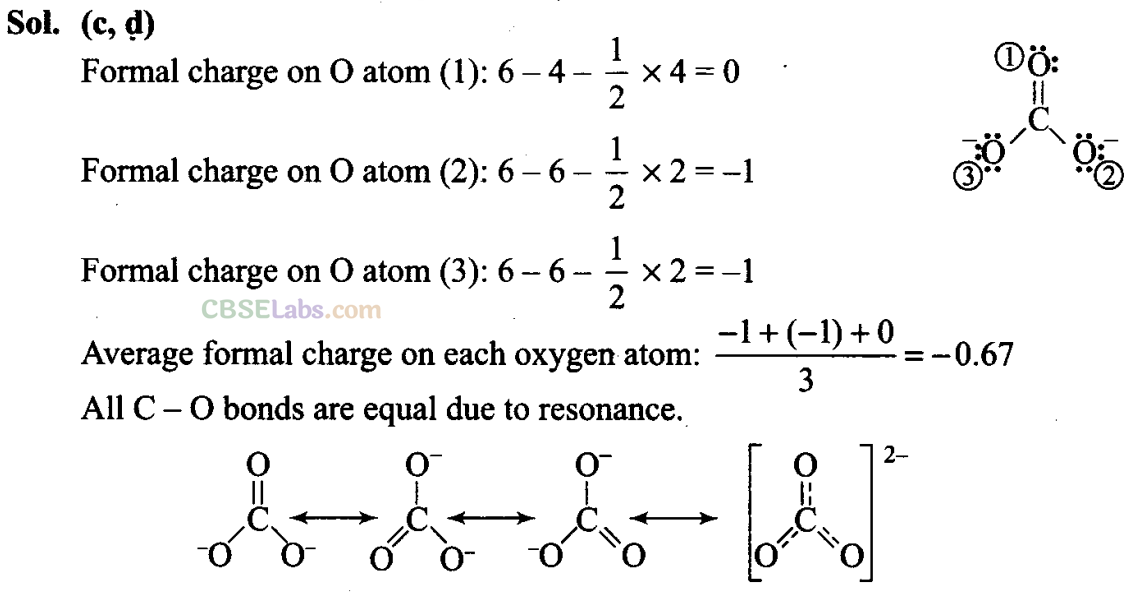
Q28. Diamagnetic species are those which contain no unpaired electrons. Which among the following are diamagnetic?
(a) N
2
(b) N
2
2-
(c) 0
2
(d) o
2
2-


Q29. Species having same bond order are
(a) N
2
(b) N
–
2
(
C
) F
+
2
(d) o
–
2

Q30. Which of the following statements are not correct?
(a) NaCl being an ionic compound is a good conductor of electricity in the solid state.
(b) In canonical structures there is a difference in the arrangement of atoms.
(c) Hybrid orbitals form stronger bonds than pure orbitals.
(d) VSEPR theory can explain the square planar geometry of XeF
4
.
Sol:
(a, b)
(a) Ionic compounds are good conductors only in molten state or aqueous solution since ions are not furnished in solid state.
(b) In canonical structures there is a difference in arrangement of electrons.
Short Answer Type Questions
Q31. Explain the
non linear
shape of H
2
S and
non planar
shape of PCl
3
using valence shell electron pair repulsion theory.
Sol:
The Lewis structure of H
2
S is:
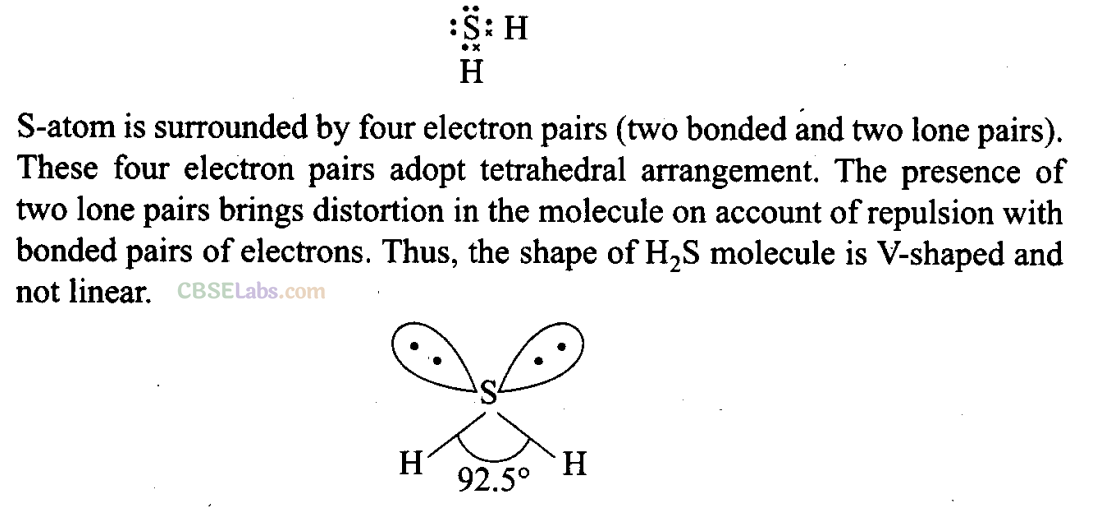
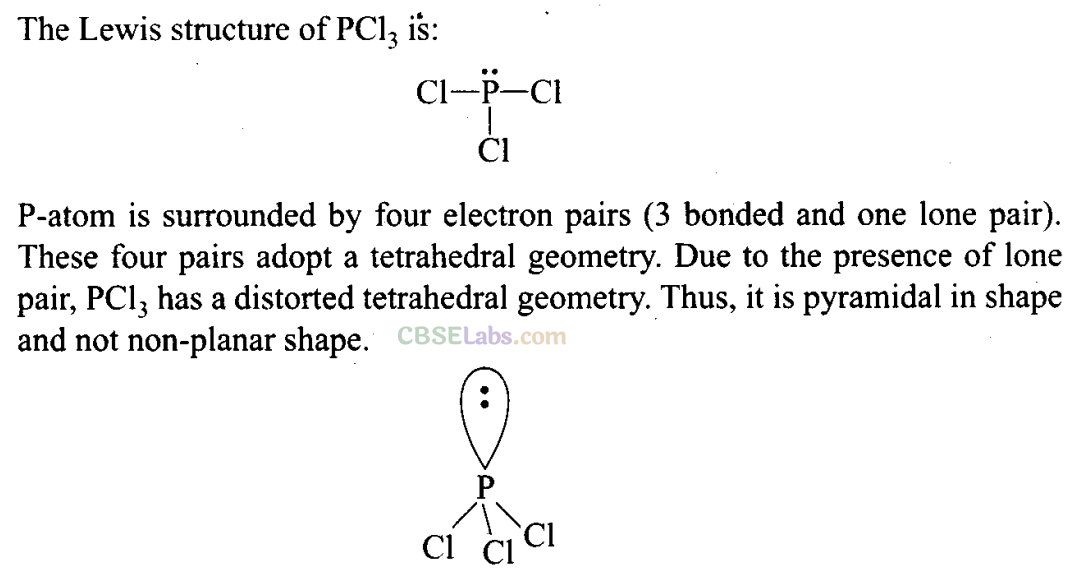
Q32. Using molecular orbital theory, compare the bond energy and magnetic character of 0
+
2
and O
–
2
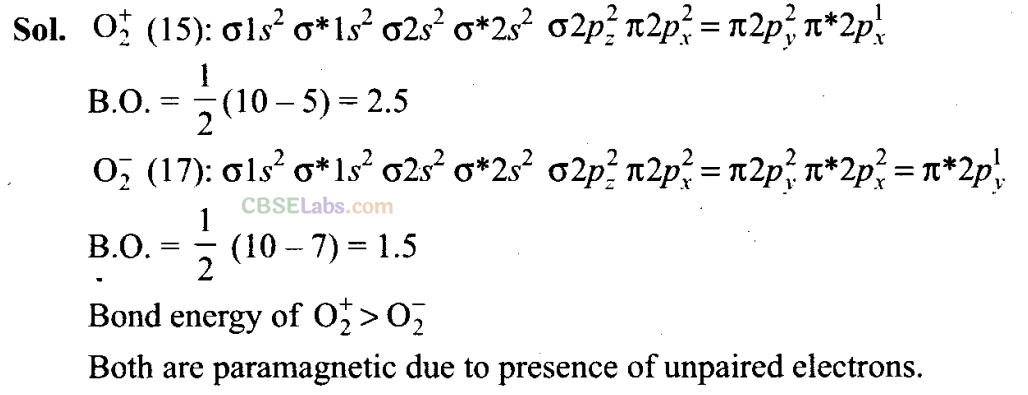
Q33. Explain the shape of BrF
5
.
Sol:
Br-atom has configuration:
1s
2
, 2s
2
2p
6
, 3s
2
3p
6
3d
10
, 4s
2
4p
5
To get pentavalency, two of the p-orbitals are unpaired and electrons are shifted to 4d-orbitals.
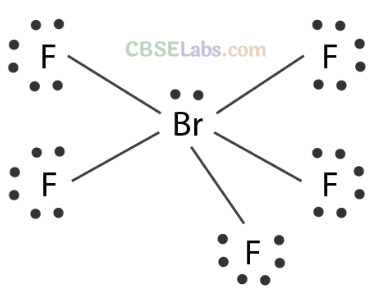
In this excited state, sp
3
d
2
-hybridisation occurs giving octahedral structure. Five positions are occupied by F atoms forming sigma bonds with hybrid bonds and one position occupied by lone pair, i.e., the molecule as a square pyramidal shape.
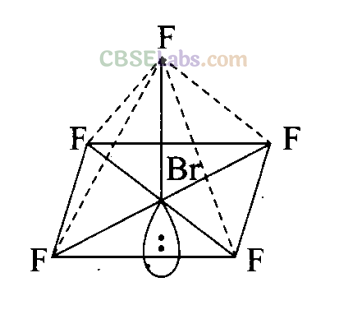
Q34. Structures of molecules of two compounds are given below:
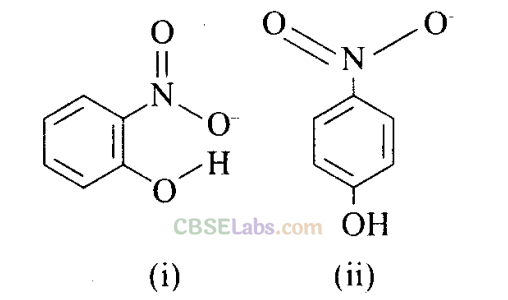
(a) Which of the two compounds will have intermolccular hydrogen bonding and which compound is expected to show intramolecular hydrogen bonding?
(b) The melting point of a compound depends on. among other things, the extent of hydrogen bonding. On this basis explain which of the above two compounds will show higher melting point.
(c) Solubility of compounds in water depends on power to form hydrogen bonds with water. Which of the above compounds will form hydrogen bond with water easily and be more soluble in it?
Sol:
(a) Compound I will form intramolecular hydrogen bond because N02 and OH groups are close together whereas it is not so in compound II. Compound II will have intermolecular hydrogen bonding. Bonding in both the cases is shown below:
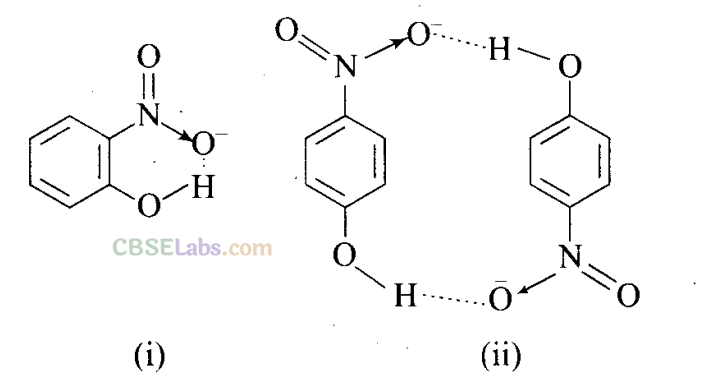
(b) As a large number of molecules can be linked together through intermolecular hydrogen bonding, compound II will show higher melting point.
(c) Due to intramolecular hydrogen bonding, compound I will not be able to form hydrogen bonds with H 2 0 molecules. Hence, it will be less soluble in water. However, compound II can form hydrogen bonds with H 2 0 molecules easily and hence it will be more soluble in water.
Q35. Why does type of overlap given in the following figure not result in the bond formation?
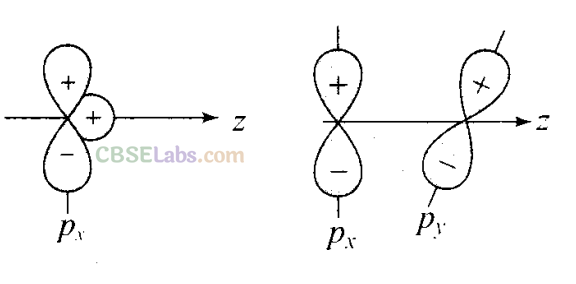
Sol:
In first figure, the ++ overlap is equal to +- overlap and therefore, these cancel out and net overlap is zero.
In second figure, no overlap is possible because the two orbitals are perpendicular to each other.
Q36. Explain why PC1
5
is trigonal bipyramidal whereas IF
5
is square pyramidal.
Sol:
PC1
5
– The ground state and the excited state outer electronic configurations of phosphorus (Z = 15) are represented below
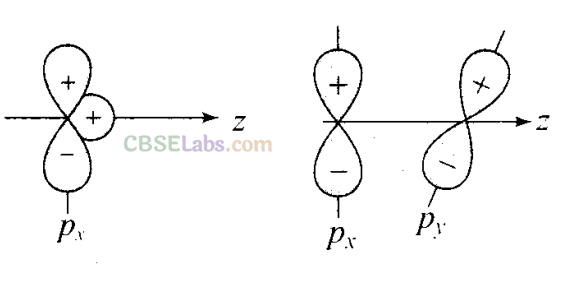
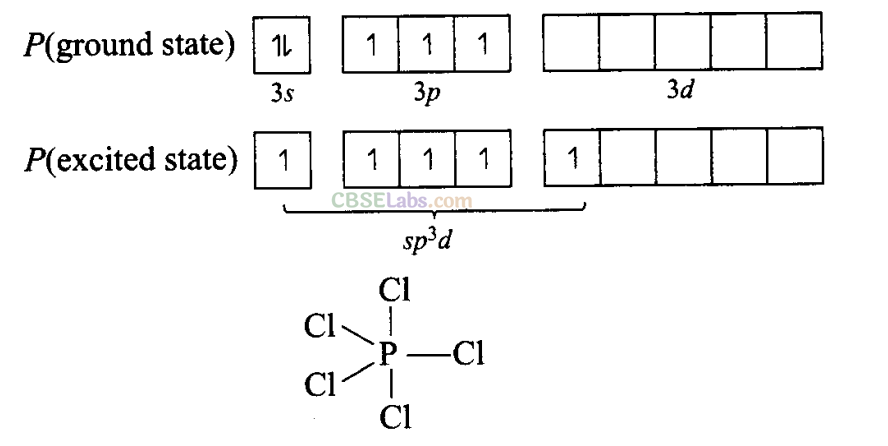

Sol: Dimethyl ether has larger bond angle than water. This is because there is more repulsion between bond pairs of CH 3 groups attached in ether than between bond pairs of hydrogen atoms attached to oxygen in water. The carbon of CH 3 group in ether is attached to three hydrogen atoms through c bonds and electron pairs of these bonds add to the electron charge density on carbon atom. Hence, repulsion between two -CH 3 groups will be more than that between two H atoms.
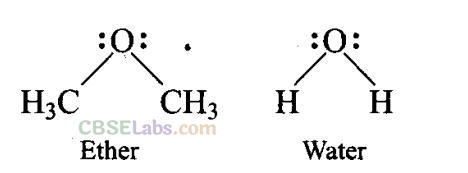
Q38. Write Lewis structure of the following compounds and show formal charge on each atom. HN0
3
, No
2
, H
2
so
4
Sol:
Formal charge on an atom in a Lewis structure
= [total number of valence electrons in free atom] – [total number of non-bonding (lone pairs) electrons]
—1/2 [total number of bonding or shared electrons]
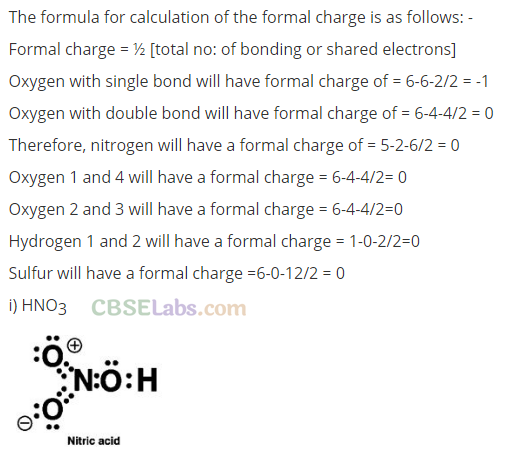
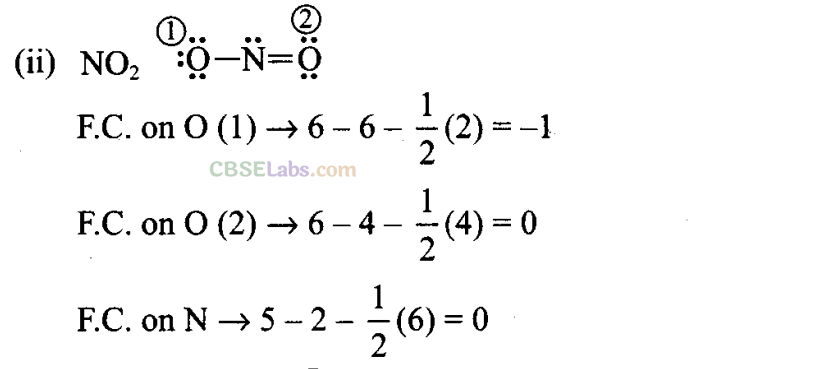
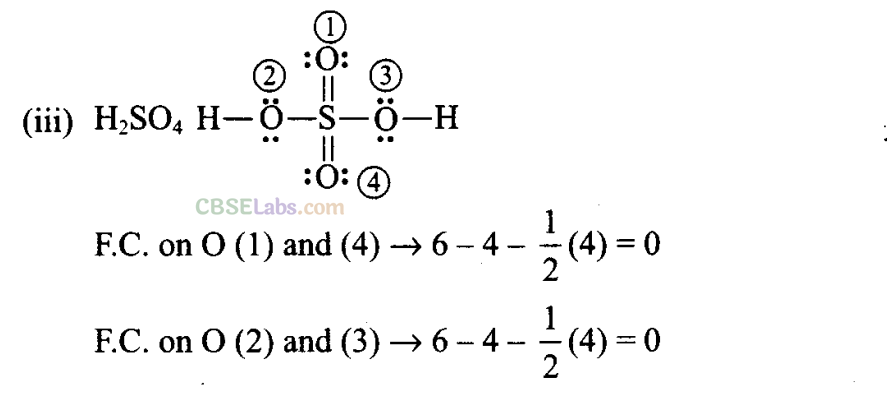

Q39. The energy of σ2p
z:
molecular orbital is greater than 2p
x
and 2p
v
molecular orbitals in nitrogen molecule. Write the complete sequence of energy levels in the increasing order of energy in the molecule. Compare the relative stability and the magnetic behaviour of the following species:
N
2
, N
+
2
, N
–
2
, N
2
2
+
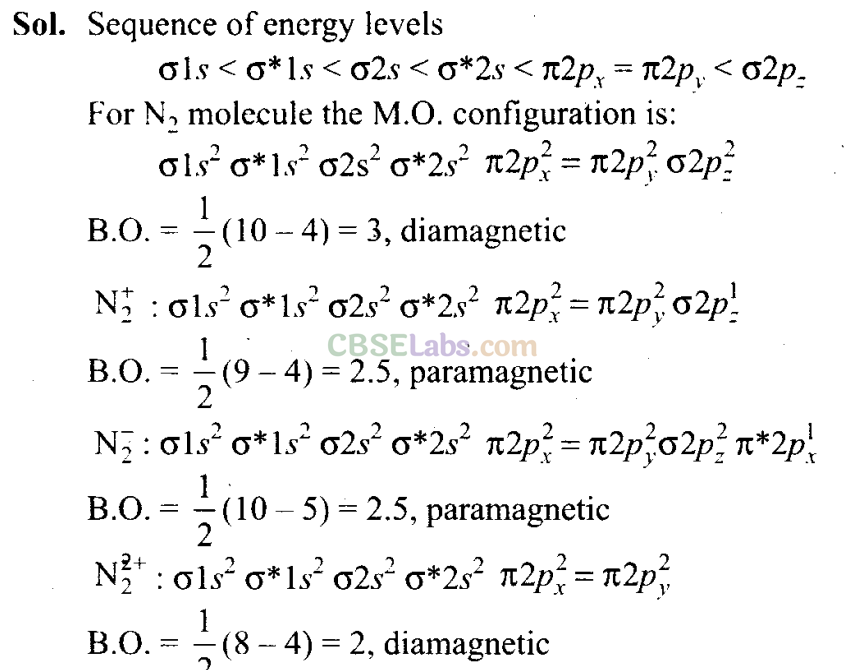

Q40. What is the effect of the following processes on the bond order in N-, and 0
2
?
(i) N
2
→ N
+
2
+ e
–
(ii) 0
2
→ O
+
2
+ e
–
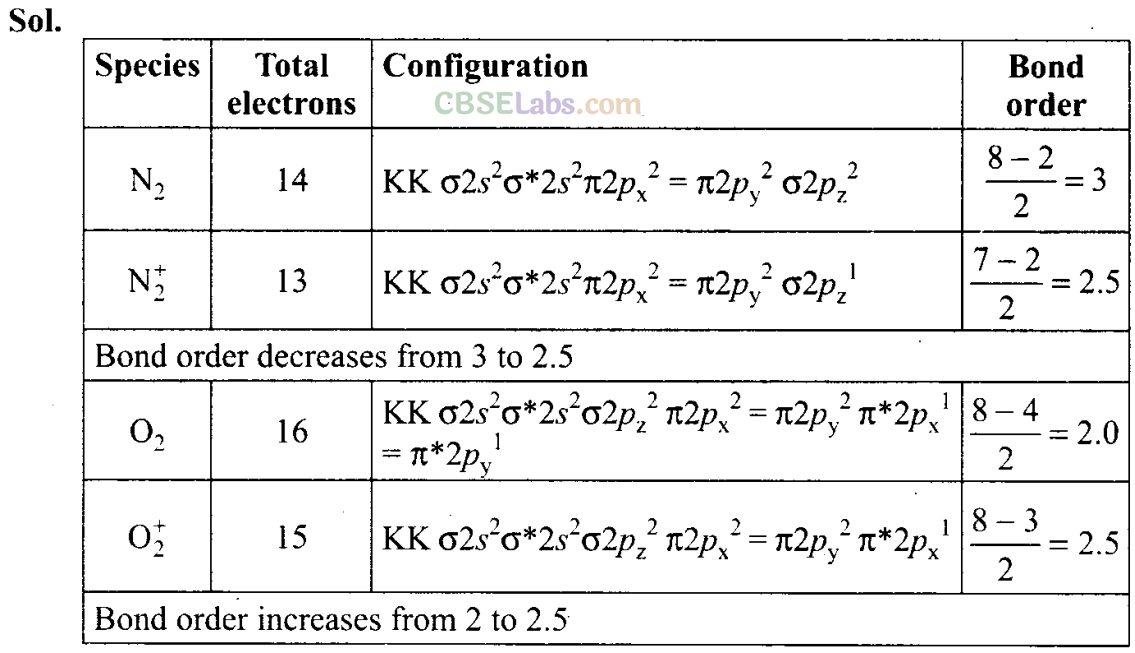
Q41. Give reasons for the following: ‘
(a) Covalent bonds are directional bonds while ionic bonds are non- directional.
(b) Water molecule has bent structure whereas carbon dioxide molecule is linear.
(c) Ethyne molecule is linear.
Sol:
(i)
Since the covalent bond depends on the overlapping of orbitals between different orbitals, the geometry of the molecule is different. The orientation of overlap is different. The orientation of overlap is the factor responsible for their directional nature.
(ii)
Due to presence of two lone pairs of electrons on oxygen atom in HiO the repulsion between Ip-lp is more. C0
2
undergoes sp hybridization resulting in linear shape (O = C = O) while H
2
0 undergoes .sp
3
hybridisation resulting in distorted tetrahedral or bent structure.
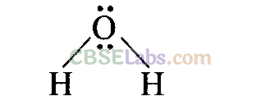
(iii) In ethyne molecule carbon undergoes sp hybridization with two unhybridised orbitals. One sp hybrid orbital of one carbon atom overlaps axially with sp hybrid orbital of the other carbon atom to form C – C sigma bond while the other hybridized orbital of each carbon atom overlaps axially with S orbitals of hydrogen atoms forming σ bonds. Unhybridised orbitals form π bonds
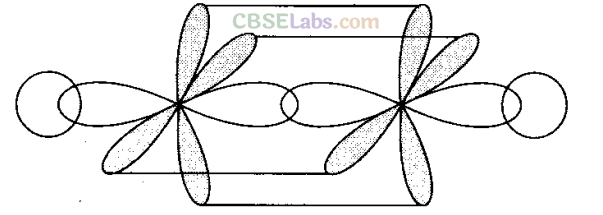
Q42. What is an ionic bond? With two suitable examples explain the difference between an ionic and covalent bond?
Sol:
An ionic bond is formed as a result of the electrostatic attraction between the positive and negative ions formed by transfer of electrons from one atom to another.
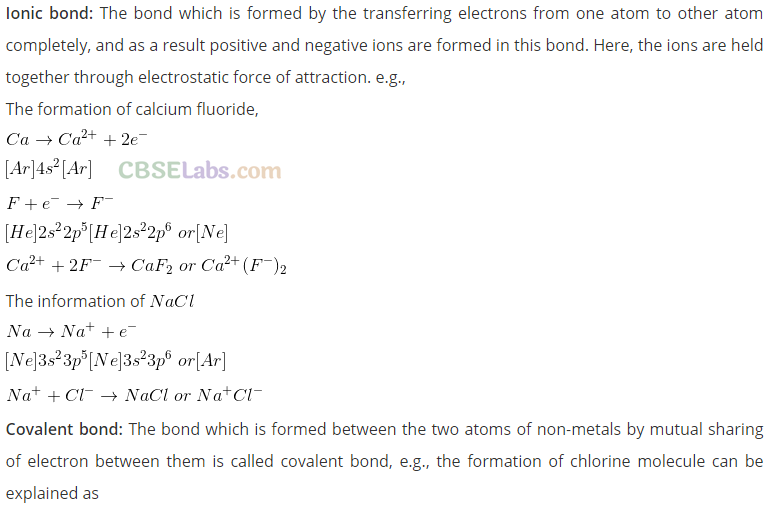
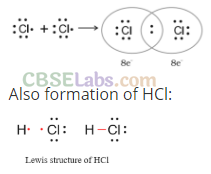
Q43. Arrange the following bonds ‘in order of increasing ionic character giving reason.
N-H, F-H, C-H and O-H
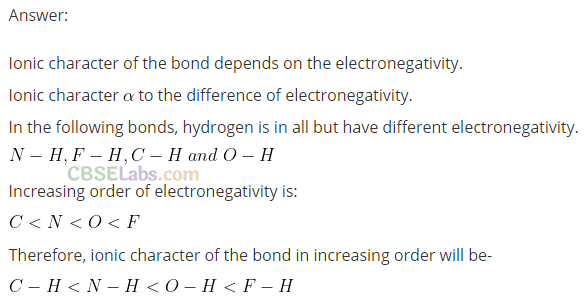
Increasing order of electronegativity difference: C-H<N-H<0-H<F-H
Greater is the difference in electronegativity between two bonded atoms, greater is the ionic character.
Q44. Explain why CO
2-
3
ion cannot be represented by a single Lewis structure. How can it be best represented?
Sol:
A single Lewis structure of CO
2-
3
ion cannot explain all the properties of this ion. It can be represented as a resonance hybrid of the following structures:

If it were represented only by one structure, there should be two types of bonds, i.e., C = O double bond and C – O single bonds but actually all bonds are found to be identical with same bond length and same bond strength.
Q45. Predict the hybridization of each carbon in the molecule of organic compound given below. Also indicate the total number of sigma and pi bonds in this molecule.
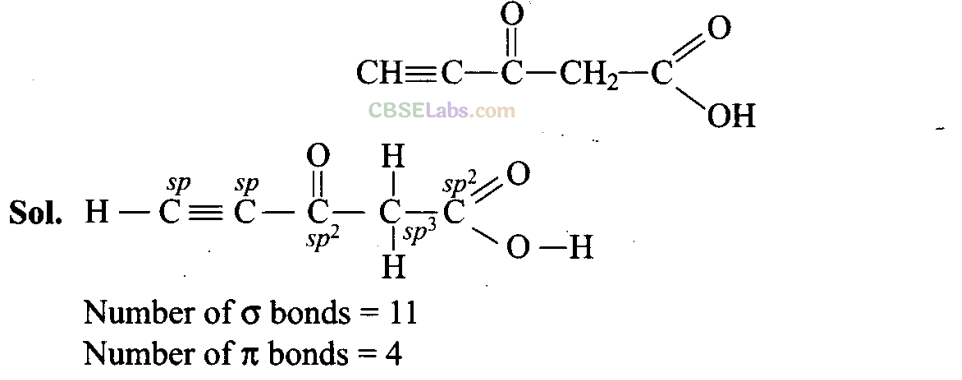
Q46. Group the following in linear and non-linear molecules: H 2 0, HOC1, BeCl 2 C1 2 0

Q47. Elements X, Y and Z have 4, 5 and 7 valence electrons respectively, (i) Write the molecular formula of the compounds formed by these elements individually with hydrogen, (ii) Which of these compounds will have the highest dipole moment?
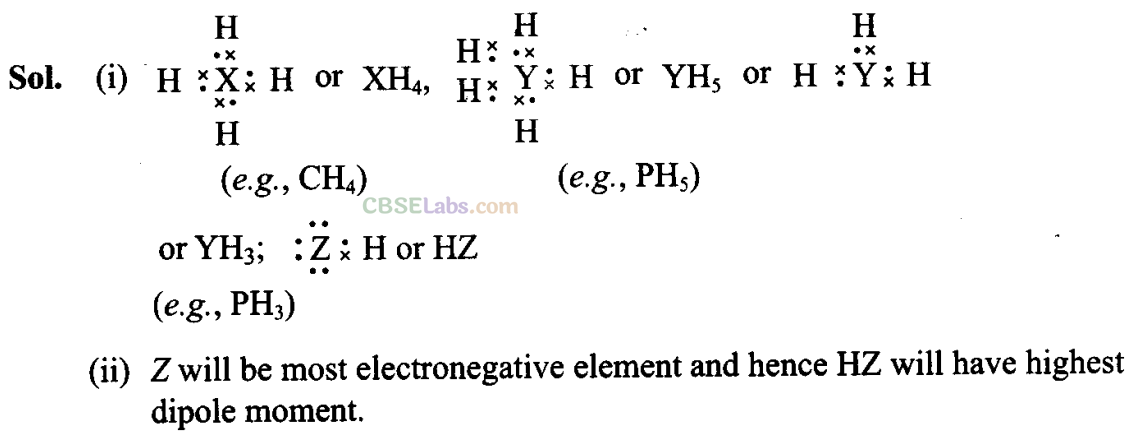
Q48. Draw the resonating structure of (i) Ozone molecule (ii) Nitrate ion
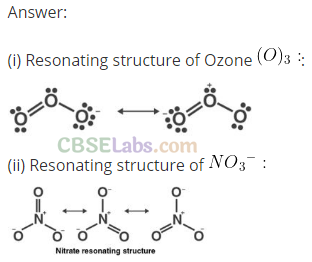
Q49. Predict the shapes of the following molecules on the basis of hybridization. BC1
3
, ch
4
, co
2
, nh
3
Sol:
BCl
3
– sp
2
hybridisation – Trigonal planar
CH
4
– sp
3
hybridisation – Tetrahedral .
NH
3
– sp
3
hybridisation – Distorted tetrahedral or Pyramidal
Q50. All the C – O bonds in carbonate ion (CO
2-
3
) are equal in length. Explain.
Sol:
Carbonate ion is represented by resonating structures as given below:
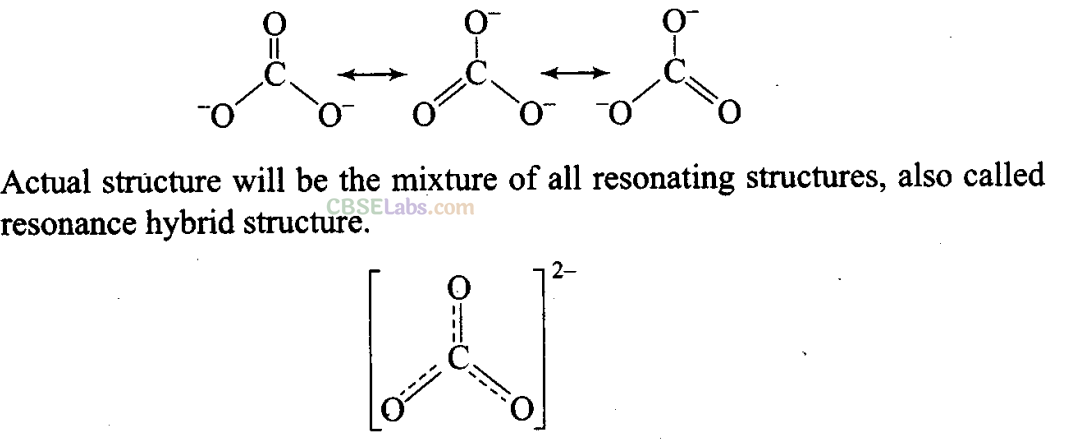
Q51. What is meant by the term average bond enthalpy? Why there is difference in bond enthalpy of O – H bond in ethanol (C 2 H 5 OH) and water?
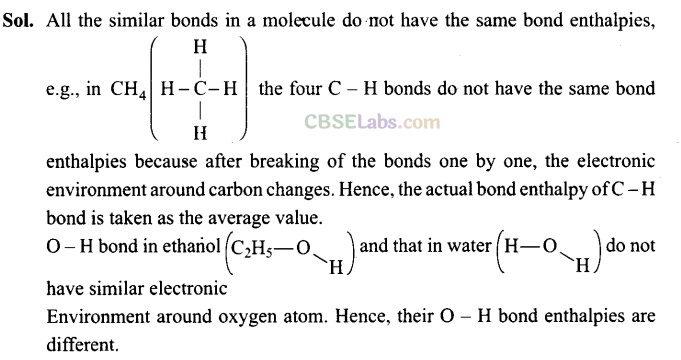
Matching Column Type Questions
Q52. Match the species in Column I with the type of hybrid orbitals in Column II.
| Column I | Column II |
| (i) SF 4 | (a) sp 3 cf |
| (ii) if 5 | (b) d 2 sp 3 |
| (iii) NO 2 + | (c) sp 3 d |
| (iv) NH 4 | (d) sp3 |
| (e) sp |
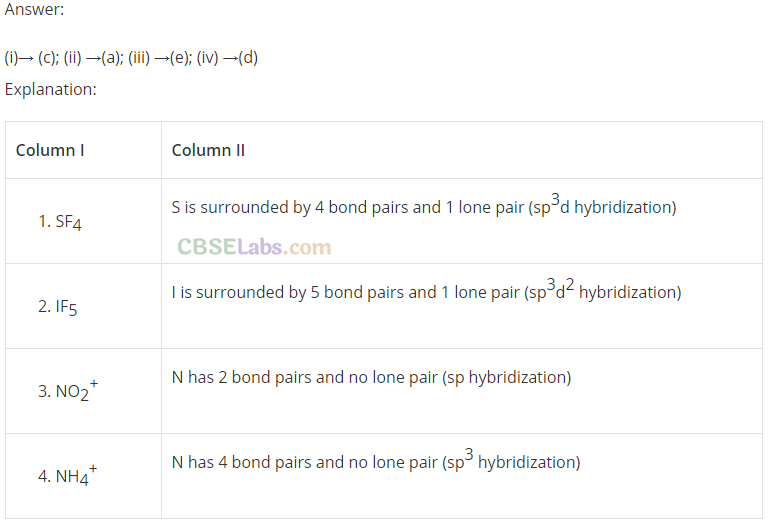
Q53. Match the species in Column I with the geometry/shape in Column II.
| Column I | Column II |
| (i) H 3 0 + | (a) Linear |
| (ii) HC = CH | (b) Angular |
| (iii) Cl0 – 2 | (c) Tetrahedral |
| (iv) NH + 4 | (d) Trigonal bipyramidal |
| – | (e) Pyramidal |
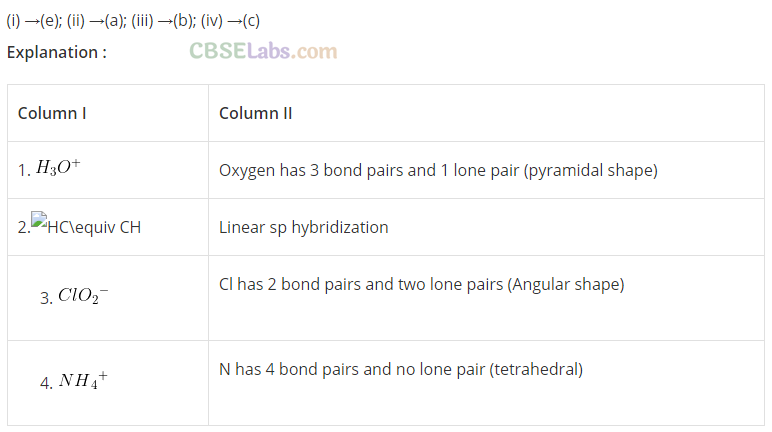
Q54. Match the species in Column I with the bond order in Column II.
| Column I | , . Column II |
| (i) NO | (a) 1.5 |
| (ii) CO | (b) 2.0 |
| (iii) o – 2 | (c) 2.5 |
| (iv) 0 2 | (d) 3.0 |
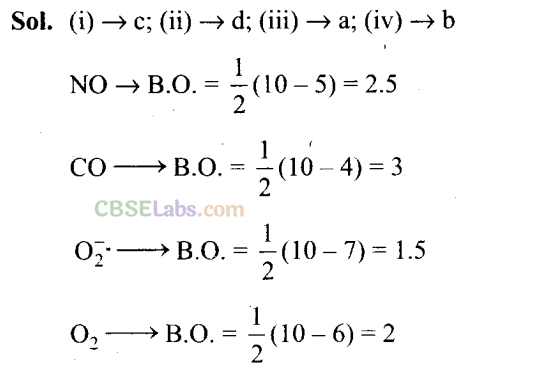
Q55. Match the items given in Column I with examples given in Column II.
| Column I | Column II |
| (i) Hydrogen bond | (a) C |
| (ii) Resonance | (b) LiF |
| (iii) Ionic solid | (c) H 2 |
| (iv) Covalent solid | (d) HF |
| (e) 0 3 |
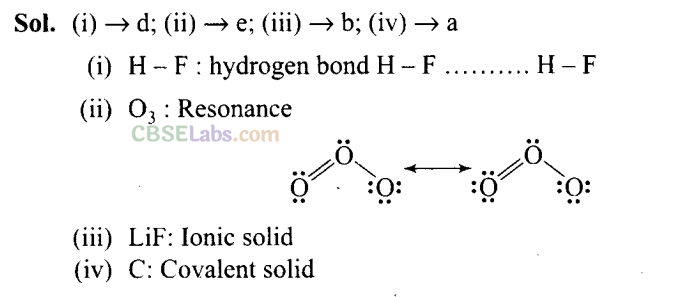
Q56. Match the shape of molecules in Column I with the type of hybridization in Column II.
| Column I | Column II |
| (i) Tetrahedral | (a) sp 2 |
| (ii) Trigonal | (b) sp |
| (iii) Linear | (c) sp 3 |
Sol: (i) →c; (ii) → a; (iii) —> b
sp
3
hybridisation – Tetrahedralshape
sp
2
hybridisation – Trigonal shape
sp hybridization – Linear shape
Assertion and Reason Type Questions
In the following questions a statement of Assertion (A) followed by a statement of Reason (R) is given. Choose the correct option out of the choices given below each question.
Q57. Assertion (A): Sodium chloride formed by the action of chlorine gas on sodium metal is a stable compound.
Reason (R): This is because sodium and chloride ions acquire octet in sodium chloride formation.
(a) A and R both are correct, and R is the correct explanation of A.
(b) A and R both are correct, but R is not the correct explanation of A.
(c) A is true but R is false.
(d) A and R both are false.
Sol:
(a) Sodium chloride (Na
+
CL
–
) is stable ionic compound because both Na
+
and CL
–
ions have complete octet in outermost shell.
Q58. Assertion (A): Though the central atom of both NH
3
and H
2
0 molecules are sp
3
hybridised, yet H – N – H bond angle is greater than that of H – O – H.
Reason (R): This is because nitrogen atom has one lone pair and oxygen atom has two lone pairs.
(a) A and R both are correct, and R is the correct explanation of A.
(b) A and R both are correct, but R is not the correct explanation of A.
(c) A is true but R is false.
(d) A and R both are false.
Sol: (a)

H
2
0 has two lone pairs while NH
3
has single lone pair, hence, H
2
0 involves greater lone pair-bond pair repulsion.
Q59. Assertion (A): Among the two O – H bonds in H
2
0 molecule, the energy required to break the first O – H bond and other O – H bond is the same.
Reason (R): This is because the electronic environment around oxygen is the same even after breakage of one O – H bond.
(a) A and R both are correct, and R is the correct explanation of A.
(b) A and R both are correct, but R is not the correct explanation of A.
(c) A is true but R is false.
(d) A and R both are false.
Sol:
(d) Bond energy of two (-O – H) bonds in H
2
0 will be different.
Long Answer Type Questions
Q60. (i) Discuss the significance/applications of dipole moment.
(ii) Represent diagrammatically the bond moments and the resultant dipole moment in C0
2
, NF
3
and CHCl
3
.
Sol:
(i) Dipole moment plays very important role in understanding the nature of chemical bond. A few applications are given below:
(a) Distinction between, polar and non-polar molecules.
The measurement of dipole moment can help us to distinguish between polar and non-polar molecules. Non-polar molecules have zero dipole
moment while polar molecules have some value of dipole moment.
(b) Degree of polarity in a molecule.
Dipole moment measurement also gives an idea about the degree of polarity specially in a diatomic molecule. The greater the dipole moment, the greater is the polarity in such a molecule.
(c) Shape of molecules.
In case of molecules containing more than two atoms, the dipole moment not only depends upon the individual dipole moments of the bonds but also on the arrangement of bonds.
.Thus, dipole moment is used to find the shapes of molecules.
(d) Ionic character in a molecule.
Knowing the electronegativities of atoms involved in a molecule, it is possible to predict the nature of chemical bond formed. If the difference in electronegativities of two atoms is large, the bond will be highly polar. As an extreme case, when the electron is completely transferred from one atom to another, an ionic bond is formed. Therefore, the ionic bond is regarded as an extreme case of covalent bond. The greater the difference in electronegativities of the bonded atoms, the higher is the ionic character
(e) Distinguish between cis- and trans- isomers
. Dipole moment measurements help to distinguish between cis- and trans- isomers because ds-isomer has usually higher dipole moment than trans isomer.
(f) Distinguish between ortho, meta and para isomers
. Dipole moment measurements help to distinguish between o-, m- and p-isomers because the dipole moment of p-isomer is zero and that of o-isomers is more than that of m-isomer.
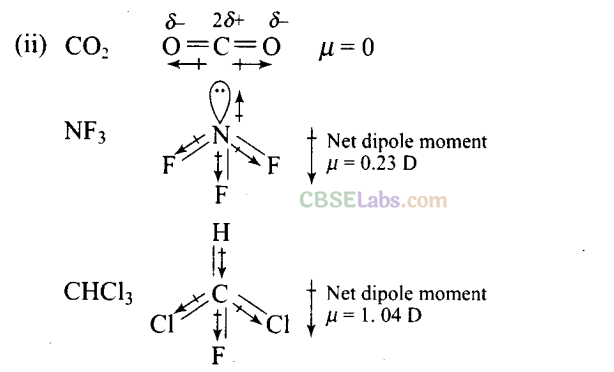
Q61. Use the molecular orbital energy level diagram to show that N 2 would be expected to have a triple bond, F 2 a single bond and Ne 2 no bond.

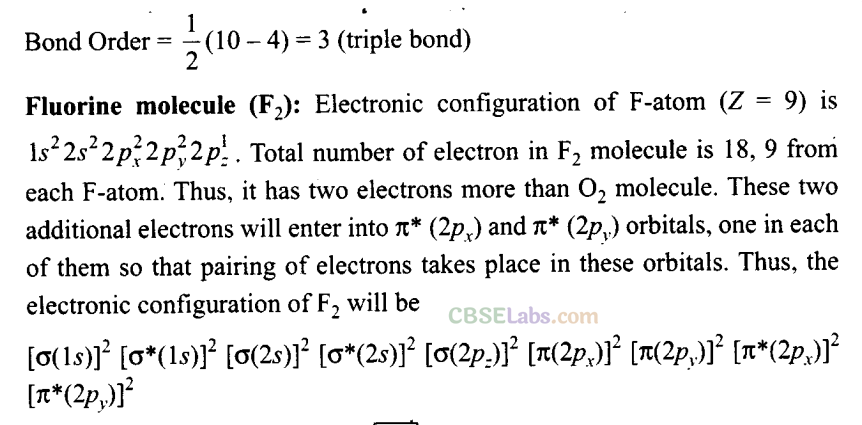
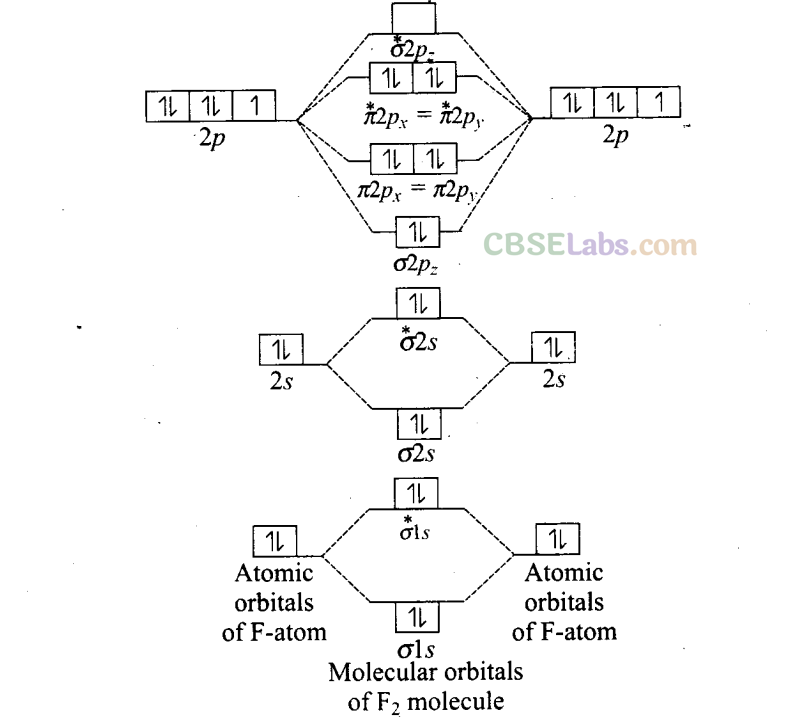
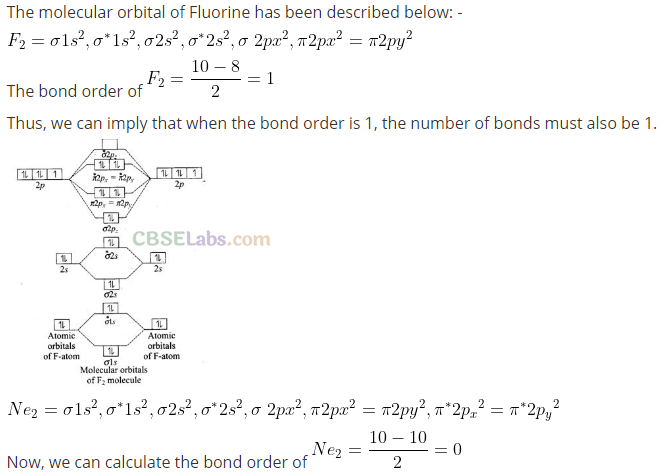
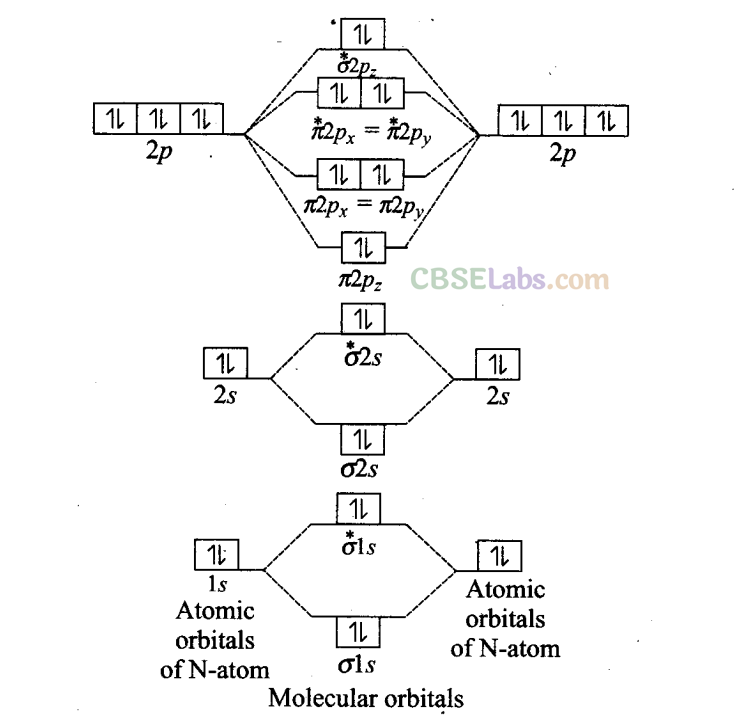
No bond is formed between two Ne atoms or in other words, Ne
2
does not exist.
Bond Order = ½ (10 – 10) = 0 (No bond)
Q62.
Briefly
describe the valence bond theory of covalent bond formation by taking an example of hydrogen. How can you interpret energy changes taking place in the formation of dihydrogen?
Sol:
The valence bond theory was put forward by Heitler and London in 1927. It was later improved and developed by L. Pauling and J.C. Slater in 1931. The valence bond theory is based on the knowledge of atomic orbitals and electronic configurations of elements, overlap criteria of atomic orbitals and stability of molecule.
The main points of valence bond theory are
(i) Atoms do not lose their identity even after the formation of the molecule.
(ii) The bond is formed due to the interaction of only the valence electrons as the two atoms come close to each other. The inner electrons do not participate in the bond formation.
(iii) During the formation of bond, only the valence electrons from each bonded atom lose their identity. The other electrons remain unaffected.
(iv) The stability of bond is accounted by the fact that the formation of bond is accompanied by release of energy. The molecule has minimum energy at a certain distance between the atoms known as intemuclear distance. Larger the decrease in energy, stronger will be the bond formed.
Valence bond Treatment of Hydrogen Molecule:
Consider two hydrogen atoms A and B approaching each other havingnuclei H
a
and H
B
and the corresponding electrons e
A
and e
B
respectively.
When atoms come closer to form molecules new forces begin to operate.
(a) The force of attraction between nucleus of atom and electron of another atom.
(b) The force of repulsion between two nuclei of the atom and electron of two atoms.
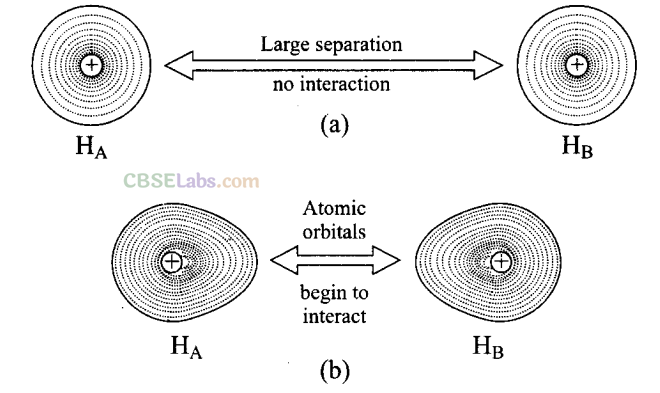
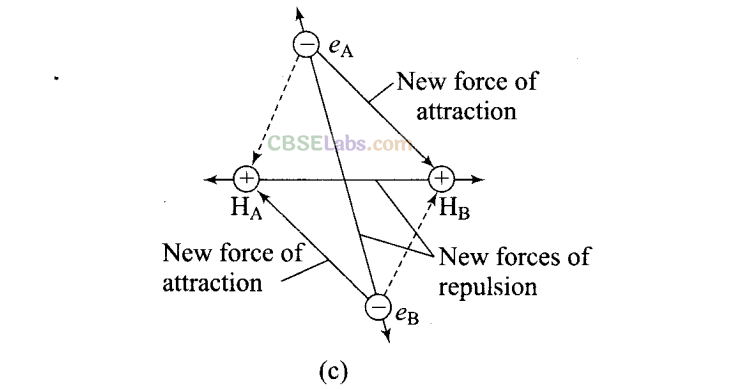
Fig. (a) Two hydrogen atoms at a large distance and hence, no interaction, (b) Two hydrogen atom closer to each other atomic orbitals begin to interact, (c) Attractive and repulsive forces in hydrogen atoms when interaction begins. In case of hydrogen: Figure ‘a’ shows that two hydrogen atoms are at farthest distances and their electron distribution is absolutely symmetrical.
(a) When two hydrogen atom start coming closer to each other, the electron cloud becomes distorted and new attractive and repulsive forces begin to operate as shown in figure ‘c’
(b) In figure ‘c’ dotted lines show attractive forces present in atom already and bold lines show the new attractive and repulsive forces.
(c) It has been found experimentally that the magnitude of net attractive forces is more than net repulsive forces. Thus stable hydrogen molecule is formed.
Potential energy diagram for formation of hydrogen molecules:
When two hydrogen atoms are at farther distance, there is no force operating between them, when they start coming closer to each other, force of attraction comes into play and their potential energy starts decreasing. As they come closer to each other potential goes on decreasing, but a point is reached, when potential energy acquires minimum value.
Note:
(a) This distance corresponding to this minimum energy value is called the distance of maximum possible approach, i.e. the point which corresponds to minimum energy and maximum stability.
(b) If atoms come further closer than this distance of maximum possible approach, then potential energy starts increasing and force of repulsion comes into play and molecules starts becoming unstable.
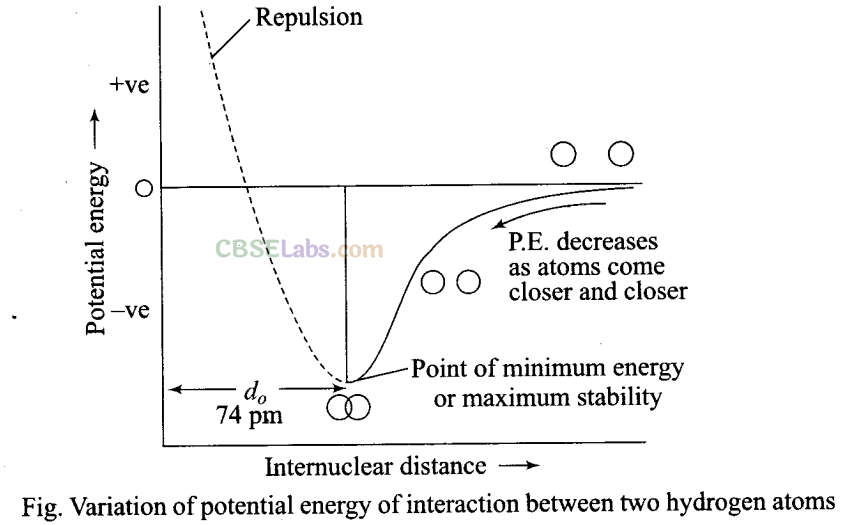
NCERT Exemplar Class 11 Chemistry Solutions
- Chapter 1 Some Basic Concepts of Chemistry
- Chapter 2 Structure of Atom
- Chapter 3 Classification of Elements and Periodicity in Properties
- Chapter 4 Chemical Bonding and Molecular Structure
- Chapter 5 States of Matter
- Chapter 6 Thermodynamics
- Chapter 7 Equilibrium
- Chapter 8 Redox Reactions
- Chapter 9 Hydrogen
- Chapter 10 The s-Block Elements
- Chapter 11 The p-Block Elements
- Chapter 12 Organic Chemistry: Some Basic Principles and Techniques
- Chapter 13 Hydrocarbons
- Chapter 14 Environmental Chemistry